No.1
Adhesion Basics
Types of Adhesives
There are various types of adhesives.
The word adhesive can refer to a considerably wide range of items.
Various adhesives are used depending on the production process and what application the customer requires the adhesive for.
There are many ways to classify adhesives.
Classification by main component
-
Inorganic adhesives
Along with cement, there are some products that can withstand temperatures of 1,000°C or higher, but they are currently in the minority.
- Silicon-based (water glass, silicate)
- Calcium-based (cement, gypsum)
-
Organic adhesives
Most adhesives are organic.
- Thermoplastic resins
- Heat-curing resins
- Rubber/elastomer
Classification by form
-
Water dispersion type
A water-based adhesive that emulsifies resin and disperses it in water.
- Epoxy resin-based
- Polyvinyl acetate-based
- Nitrile rubber-based
-
Solvent type
An adhesive in which a resin is dissolved in a solvent, such as a volatile-solvent type adhesive.
- Phenol resin
- Polyvinyl acetate
- Chloroprene rubber-based
-
Solvent-free type
An adhesive that cures by a chemical reaction, such as silicone rubber-based or epoxy resin-based.
- Epoxy resin-based
- Acrylic resin-based
- Silicone rubber-based
-
Solid type
A solid type adhesive such as agglomerated, powder, or film.
- Epoxy resin-based
- Styrene-butadiene rubber-based
Classification by curing method
-
Volatile-solvent type
This type cures as the organic solvent volatilizes.
(Examples) Rubber glue, adhesive for plastic models- Polyvinyl acetate
- Nitrile rubber-based
-
Moisture curing type
This type reacts with the moisture in the air and hardens.
(Examples) Instant adhesive, silicone-based liquid gaskets- Cyanoacrylate-based
- Silicone rubber-based
-
Heat curing type
The curing agent in the resin is activated and hardened through applying heat.
(Example) One-part epoxy resins- Epoxy resin-based
- Acrylic resin-based
-
Mixed type
Curing occurs, when the base agent is mixed with a hardener.
(Example) Two-component epoxy resins- Epoxy resin-based
- Silicone rubber-based
- Acrylic resin-based
-
Anaerobic curing type
This type cures when the air is blocked and when the adhesive makes contact with metal.
It is used for screws, joints, pipes, etc.- Acrylic resin-based
-
UV curing type
This type cures in a short time by irradiating with ultraviolet rays.
It is used for bonding/sealing glass and transparent plastics.- Acrylic resin-based
- Epoxy-resin-based
-
Heat melting type
This type is applied in a molten state, and when it cools, it hardens and adheres.
It is used for packaging and bookbinding.- Styrene-butadiene rubber-based
-
Pressure sensitive type
Adhesion is performed by applying pressure at room temperature.
This type is used for adhesive tapes and seals.- Acrylic resin-based
-
Two-time humidifying type
This type is an adhesive that can be bonded after recovering the adhesiveness by wetting the dry adhesive surface such as wetting stamps with water.
- Chloroprene rubber-based
- Starch type
Adhesive Theory
So what actually is adhesive?
The following is a brief explanation of the concept of adhesion.
Firstly, let us consider the factors that determine the strength of adhesion.
Adhesive strength will be an important factor in your design requirements.
Factors that determine the strength of adhesion
Wetting and contact angle
Ideally, the adhesive should completely wet out on the substrate.
Adhesion strength varies depending on the wetness that can be measured by the contact angle.
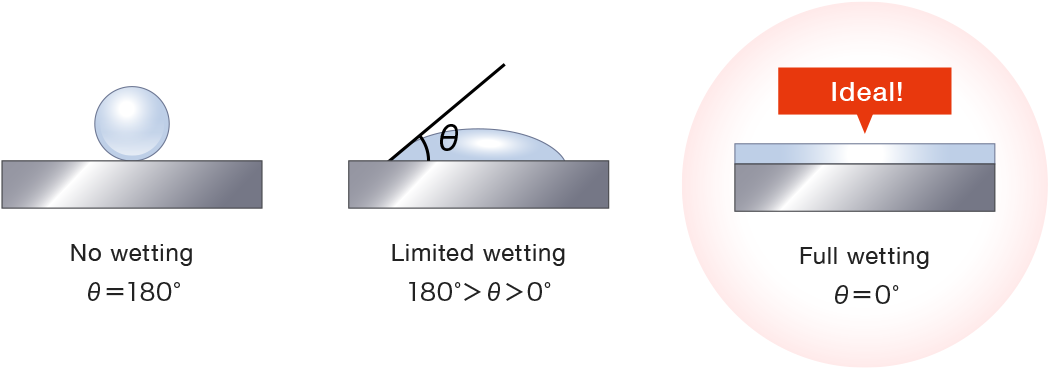
How the bond works
There are various theories about the mechanism of bonding. Adhesion strength varies depending on each bonding process.
The following theories explain the mechanism by which bonding occurs.
-
Chemical bond theory
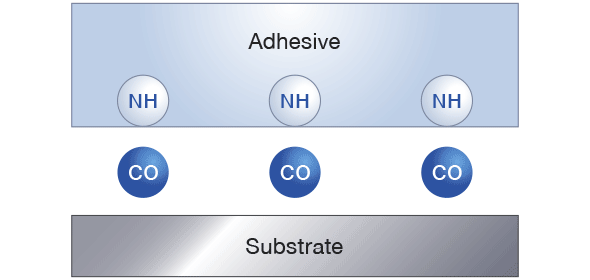
The adhesive causes a chemical reaction between the substrate and the adhesive. Molecules are bonded to each other by this chemical reaction, so the adhesion is strong.
-
Adsorption theory
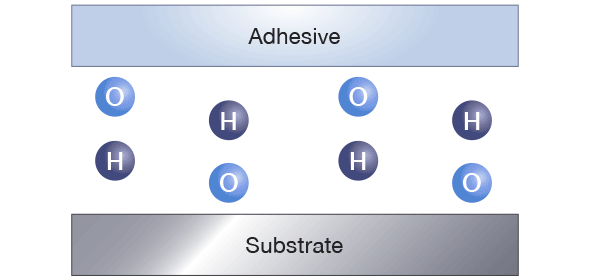
A hydrogen bond is formed between the adhesive and the adherend, creating a force that attracts them to each other. The binding energy of hydrogen bonds is weaker than that of chemical bonds.
-
Anchoring effect theory
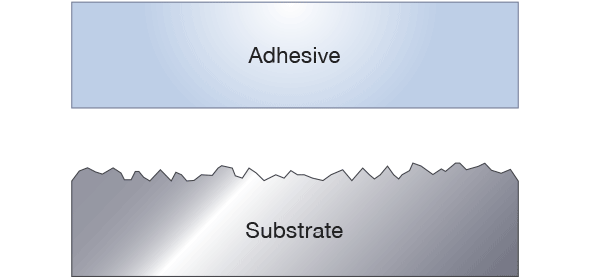
The adhesive bonds by entering the gaps on the surface of the substrate. Adhesive strength changes depending on the magnitude of the anchoring effect.
-
Electrostatic theory
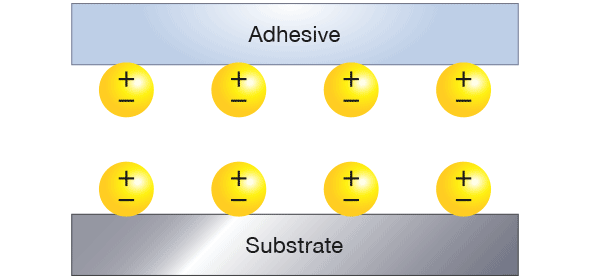
This is the bonding force created by the effect of so-called static electricity. Its adhesive strength is weaker than that of hydrogen bonds.
-
Mutual diffusion theory
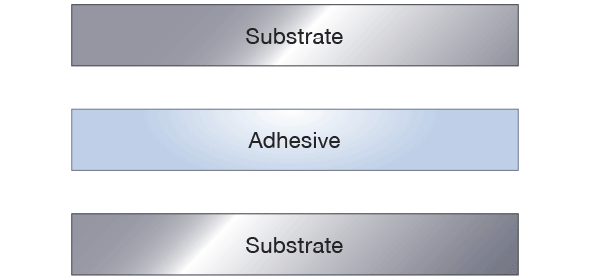
The adhesive melts the substrate, causing the two objects to melt and bond together. Since the two objects melt together, the adhesive strength is stronger than that of chemical bonds.
How the adherend receives a peeling force
There are various ways in which force may be applied to the adherend to result in peeling.
The adhesive selection and application method are derived through consideration of the following ways in which force is applied.
-
Pulling force upward and downward (tension)
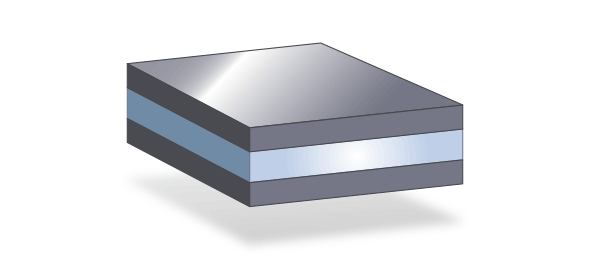
-
Shifting force (shearing)
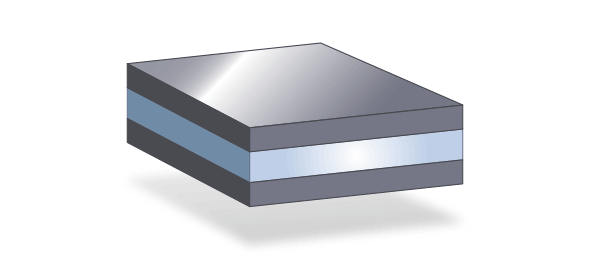
-
Peeling force when pulling from the edge (cleavage)
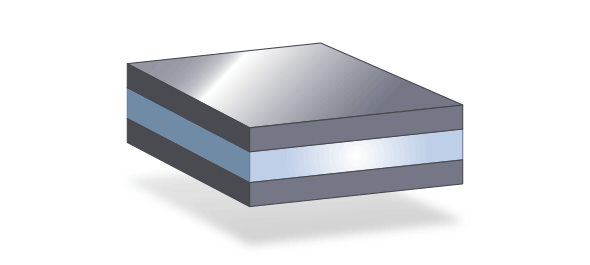
-
Rolling up force (peeling)
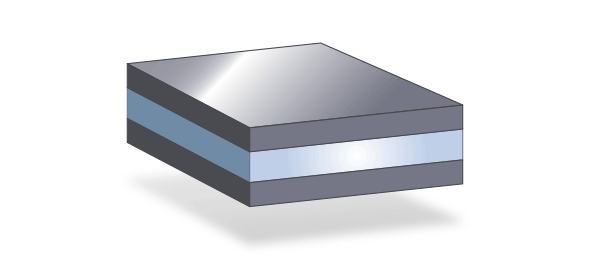
How to choose an adhesive
When choosing an adhesive, you need to consider the following.
From the viewpoint of the magnitude of external force and load applied to the joint
- Required adhesive strength
- Presence or absence of chemicals
- Structural design of joints
- Durability
- Temperature and humidity during production
From the viewpoint of the material and surface condition of the substrate
- Contamination of oil or dirt
- Material that is hard to bond/oxide coating
- Surface roughness and smoothness
From the viewpoint of operability and automation
- Allowable curing time and aging time
- Ease of handling
- Ease of application
- Ease of storage
From the viewpoint of health and safety
- Impact on the external environment
- Laws and regulations (Fire Service Act, Industrial Safety and Health Act, etc.)
- Health and safety measures and first aid for workers
Summary
It is important to select an adhesive by taking the above factors into consideration comprehensively, then deciding the design requirements.
Don't hesitate to tell us your design requirements.
At ThreeBond, we strive to create products that best meet your design requirements.
